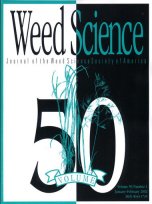Glyphosate treatments to glyphosate-resistant (GR) cotton have been associated with poor pollination and increased boll abortion. Anatomical studies were conducted to characterize the effect of glyphosate treatments on the development of male and female reproductive organs of cotton flowers at anthesis. In comparison with nontreated plants, glyphosate applied at both the four-leaf stage postemergence (POST) and at the eight-leaf stage POST directed inhibited the elongation of the staminal column and filament, which increased the distance from the anthers to the receptive stigma tip by 4.9 to 5.7 mm during the first week of flowering. The increased distance from the anthers to the stigma resulted in 42% less pollen deposited on stigmas of glyphosate-treated plants than in nontreated plants. Moreover, pollen from glyphosate-treated plants showed numerous morphological abnormalities. Transmission electron microscopy showed the presence of large vacuoles, numerous starch grains, and less organized pockets of the endoplasmic reticulum containing fewer ribosomes in pollen from glyphosate-treated plants than from nontreated plants. Pollen development in glyphosate-treated plants is likely inhibited or aborted at the vacuolate microspore and vacuolate microgamete stages of microgametogenesis, resulting in immature pollen at anthesis. Although stigmas from glyphosate-treated plants were 1.2 to 1.4 mm longer than those from nontreated plants, no other anatomical differences in stigmas were visibly evident. The presence of the GR 5-enolpyruvylshikimate-3-phosphate synthase (CP4-EPSPS) enzyme from Agrobacterium sp. strain CP4 was quantified in reproductive and vegetative tissues using enzyme-linked immunosorbent assay. The content of CP4-EPSPS in the stigma, anther, preanthesis floral bud (square), and flower petals was significantly less than that in the vegetative leaf tissue. Glyphosate effects on the male reproductive development resulting in poor pollen deposition on the stigma, as well as production of aborted pollen with reduced viability, provide a likely explanation for reports of increased boll abortion and pollination problems in glyphosate-treated GR cotton.
Nomenclature: Glyphosate; cotton, Gossypium hirsutum L. ‘Delta Pine & Land 5415RR’, ‘Delta Pine & Land 50’, ‘Delta Pine & Land 90’, ‘SureGrow 125RR’.





